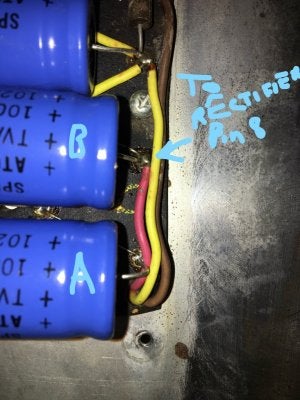Jariggs
TDPRI Member
Hi. I took the chassis out of my my early 70s Pro Reverb to add a bias adjust pot. When opened up the doghouse to verify no voltage was in the capacitors, I noticed that one of the filter caps seemed backwards based upon what I have seen in other silverface fenders. In other amps, the capacitor in the far left in this picture is usually laid out in the opposite polarity from all the other capacitors. There is continuity to ground for on the positive end of that capacitor. 
I've had the amp over a year now, and while it worked it has always been a little noisy. Maybe this is why? I am pretty sure of the answer, just a little new to working on amps and would appreciate opinions/validation. Thanks!

I've had the amp over a year now, and while it worked it has always been a little noisy. Maybe this is why? I am pretty sure of the answer, just a little new to working on amps and would appreciate opinions/validation. Thanks!


